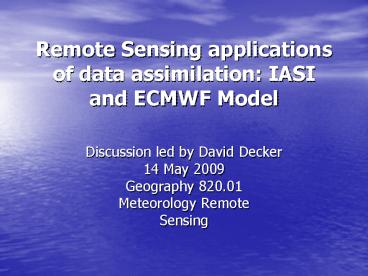Remote Sensing applications of data assimilation: IASI and ECMWF Model - PowerPoint PPT Presentation
1 / 29
Title:
Remote Sensing applications of data assimilation: IASI and ECMWF Model
Description:
Quarterly Journal of the Royal Meteorological Society, Volume 135, Issue 639, p ... Assimilation of IASI at the Met Office and assessment of its impact through ... – PowerPoint PPT presentation
Number of Views:99
Avg rating:3.0/5.0
Title: Remote Sensing applications of data assimilation: IASI and ECMWF Model
1
Remote Sensing applications of data assimilation
IASI and ECMWF Model
- Discussion led by David Decker
- 14 May 2009
- Geography 820.01
- Meteorology Remote
- Sensing
2
Discussion Articles
- F. Hilton, N. C. Atkinson, S. J. English, and J.
R. Eyre Assimilation of IASI at the Met Office
and assessment of its impact through observing
system experiments. Quarterly Journal of the
Royal Meteorological Society, Volume 135, Issue
639, p 495-505, DOI 10.1002/qj.379. - Peter Bechtold, Martin Köhler, Thomas Jung,
Francisco Doblas-Reyes, Martin Leutbecher, Mark
J. Rodwell, Frederic Vitart, and Gianpaolo
Balsamo Advances in simulating atmospheric
variability with the ECMWF model From synoptic
to decadal time-scales. Quarterly Journal of the
Royal Meteorological Society, Volume 134, Issue
634, p 1337-1351, DOI 10.1002/qj.289.
3
Infrared Atmospheric Sounding Interferometer
(IASI) Background
- Andersson et al. 1994 concluded that IASI
provides higher vertical resolution information
of temperature and water vapor content in the
atmosphere than other operational infrared
sounders (i.e., HIRS) - Collard (1998) concluded that IASI concluded that
results were improved 5xs that of HIRS when
expressed in degrees of freedom.
4
Assimilation of IASI at the Met Office and
assessment of its impact through observing system
experiments
- Quality of IASI data
- How are data selected prior to assimilation?
- Impact of IASI in the NWP system from two
one-month test periods - -Summer 2007 (24 May 2007 - 24 June 2007)
- -Winter 2007 (12 December - 12 January 2008)
- How does IASI perform with other satellite
sounding instruments?
5
IASI data quality assessment
6
IASI assimilation methodology
- All 8461 IASI channels were processed under a
6-hr assimilation cycle. 314 channels were used
for the IASI expected fit quality assessment just
discussed. - Difficult to extract detailed atmospheric
information - Spatial and spectral data reduction approach was
taken. - Use 3000 observations for the 6-hr assimilation
cycle. - 4- dimensional variation analysis assimilation is
used. - -Recall, 3 dimensions of movement and
time
7
Global model assimilation trials
- Summer 2007
8
- Winter 2007
9
? in forecast RMSE for June 2007 and
December 2007
10
Global model observing system experiments
11
(No Transcript)
12
(No Transcript)
13
Summary
- In the no-satellite-sounding baseline suggest
that IASI provides similar improvement results in
forecast skill to AMSU-A MHS, and IASI provides
a higher level of improvement compared to HIRS or
AIRS based on an equivalent clear-observation-only
assimilation scheme. - Geopotential height and PMSL assimilating
clear-sky observations are not yet feeding into
surface weather variables as seen in the North
Atlantic and European model. - The best improvement was achieved with a simple
assimilation scheme treating IASI in the same way
as the previous generation sounding instruments.
14
Pop QUIZ!
- Name two physical processes that generate kinetic
energy in the atmosphere? - Any takers?
15
ECMWF Cy32r3
- Model cycle
- 6 November 2007
- Contains important modifications made to the
convection and vertical diffusion scheme. - Discussion
- - performance compared to previous ECMWF
model cycles - - deficiencies of previous versions of the
ECMWF Integrated Forecast System - - consequences of model changes for high
resolution 15-day forecasts with EPS and monthly
forecasts - - effects on decadal simulations
16
- It is important to get equatorial Rossby, Kelvin
and mixed Rossby waves correct in global models
as they are sensitive to how the convective
parameterization is used. - - Negative consequences the errors make
very noticeable changes in the Madden-Julian
Oscillation (MJO) and in the quasi-biennial
oscillation (QBO) - Vertical diffusion scheme controls the
friction/dissipation and acts on the tropospheric
wind shear and temperature gradients that impact
mid-latitude synoptic system development.
17
Model Physics
- Turbulent and organized entrainment and
detrainment contributes to the convective mass
flux which varies with height - Modeling entrainment
18
Probability density functions with different
resolutions
19
ECMWF model cycles compared to the GPCP
20
ECMWF model cycle performance over the Amazon
basin and partly over Andes
21
Wavenumber-frequency spectra of predicted L
over region
22
Average zonal mean zonal winds
23
Extratropical Cyclone Tracking
24
850 hPa and 950 hPa Temperature Test
25
Satellite imagery and mesoscale variability
26
Quantitative Verification of Satellite imagery
and mesoscale variability
27
Model cycle amplitude verification on the
Extratropics (10N, 10S)
28
Representing MJO with Integrated Forecasting
System
29
ECMWF Model Simulations in Decadal integrations































